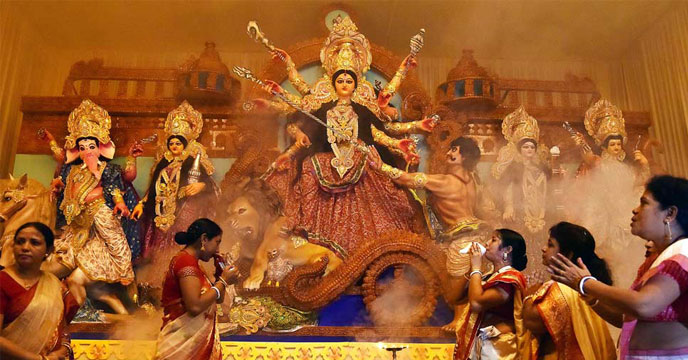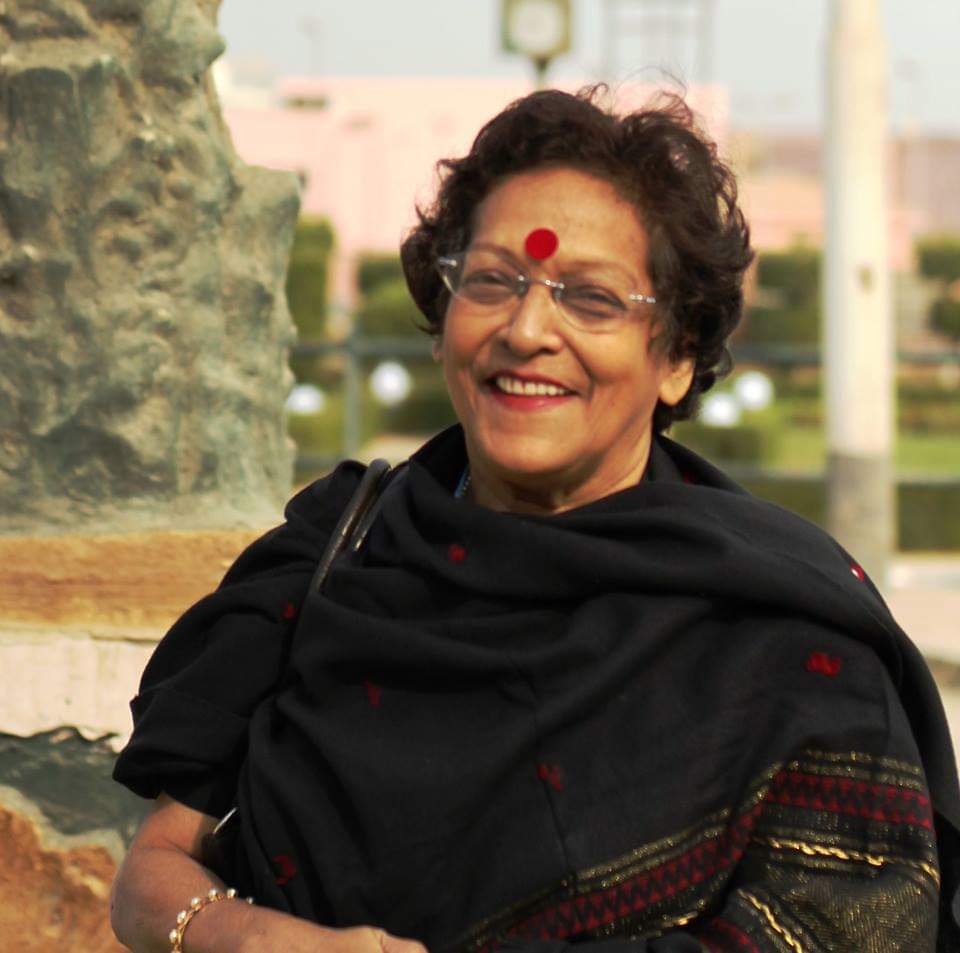For Bengalis across the world, Durga Puja is not just a festival, it is a part of the Bengali culture that no amount of political jugglery and infighting, electoral disturbances, globalisation and modernisation has been able to do away with. For many artists and artisans, it is also a way of life which offers them either the only source of earning their bread, or a seasonal occupation to earn some extra money.
The story behind the Puja
The unitary concept of Sakti did not evolve into any solid personification of the goddess Durga until the 6th century A.D. The Devimahatmya section of the Markandeya Purana (chapters 81-93), variously known as Durgashaptasati and Chandimahatmya, expounds the splendour and majesty of the divine goddess and proclaims her sovereignty over the male pantheon. The abbreviated form of poetic verses as they appear in the Devi-sukta appears in an expanded, narrative form in the Devimahatmya. Here, the goddess is portrayed without a male escort. Durga, unlike Parvati, Lakshmi and Sita, owes her autonomy to herself.
The legend: When the gods in heaven failed to suppress the oppression of the demon Mahisasura, they appealed to Vishnu and Shiva. In their anger and their powerlessness, the gods spouted streams of fire from their mouths. The combined mass of energy took the shape of a single flame, with distinct qualities derived from each of the gods. This flame condensed into a concrete form of a multi-armed Goddess – Durga. This divine woman comprised of the potent energies of each god who spouted fire, was given weapons and a lion as her vehicle. When the Gods saw the result of their collective wrath, they paid their obeisance to this Adi Sakti, the perennial abstract-neuter energy, and the individuated manifestation of the infinite cosmic energy in female form. In the fierce battle that ensues, Durga defeats the demons one by one. During the most uncontrollable phase of this war, she spontaneously creates, from her brow, a wrathful form of herself, and this is Kali.
The story goes that the Goddess is immersed in the Ganges on the last day because she can go back to Kailash only along a watery route. It is the Arabian Sea in Mumbai, the Bay of Bengal in Bangladesh, or the Icchamoti River. On the morning of Bijoya Dashami, married women of all ages play around with vermillion powder or sindoor just like people play with gulaal during Holi. Red-bordered white saris in different textures and styles are in great demand among married women on Asthami, the eight day of the festival.. Traditional royal families of Kolkata even bring out a daily bulletin during puja days.
Another story is that since the Goddess is shaped out of clay from the Ganges, she should go back to the Ganges! On this day, the public transport system is stopped post-lunch to make way for the dancing and singing and drumming away to the river banks.
The festive spirit
During Durga Puja the entire state in West Bengal and Bengali neighbourhoods in other Indian cities come alive as if with the touch of an invisible magic wand. Strung across every street, lane and road are colourful buntings, banners, paper streamers and floral decorations, with loudspeakers put up in every corner playing songs from Hindi and Bengali films. There are at least four collective Puja mandaps along every street, blocking vehicular traffic for all five days of the festival, with serpentine queues the order of the day.
Multicoloured lights spark up the evenings with decorations suggesting the World Cup, or a string of massive puppets shaped to represent Maa Durga and her kids, suspended from a string. Tinsel ribbons flutter away in the breeze and bawling kids harass their mothers for one more cup of ice-cream! The air is rich with the fragrance of dhoop, incense sticks, flowers and sandalwood. The kitchen goes dry because everyone eats out. No one goes to the movies but those who cannot go pandal-hopping, must sit back and watch the fun on the television news channels that give a minute-by-minute display of the festival!
The backstage workers
Drummers or dhakis arrive from their original habitats in villages of Murshidabad and Behrampur to look for work. They are an integral part of any Bengali festival in general, and Durga Puja in particular. The dhak, a traditional percussion instrument mandatory for every religious festival among Bengalis across the world is a must. These dhakis arrive at Sealdah station just before the Durga Puja. With modernity and due to lack of government assistance of any kind, their lives and their music stand threatened by extinction.
The work is seasonal and pays much less compared to the labour and the money they put in for buying the dhak or replacing it when needed. A young man who trains with a group of six in Andiron in Beldanga explains how different rhythms and beats are used for different events during Durga Puja – one when the Goddess is being taken to the mandap, one when she is welcomed, one when she is being worshipped, one when she is taken to the ghat for immersion, another one for the actual immersion ceremony changing with each ritual performed at the mandap.
The clay workers of Kumartuli
The clay image makers are an institution unto themselves. In 1757, Lord Robert Clive and the East India Company won the first military victory for British arms on Indian soil at the Battle of Plassey, defeating the Moghul Nawab. Members of the urban Hindu elite of Calcutta who supported the British, decided to celebrate it with a Durga Puja. Clay images were then made by the craftsmen of Krishnanagar. Most of them later migrated to Calcutta and settled in Kumartuli. The name Kumartuli is derived from kumore meaning potter, which the craftsmen originally were, and tuli meaning their small place of shelter. As Calcutta grew as a centre of trade and administration during the British rule, these potters by caste became the core settlers of Kumartuli, or the Potters’ Quarters.
Around 4,000 idols of Durga are created in the 450-and-odd narrowly built workshops or studios in Kolkata’s Kumartuli, the hub centre of idol makers who make idols of Durga, her four children, her lion and the demon Mahisasura. But, even in the 21st century, this cottage industry, also scattered in different parts of the city and the state of West Bengal, continues to be a creative space dominated almost entirely by men. Women, born or married into the families of these potters/artisans, are not really encouraged to join the trade, and in some families, are prohibited from becoming idol makers for the sole reason that they are women. So, at the most, we have not more than a dozen women who have broken the barriers, not only to become idol makers, but have also flourished in the business through courage, conviction and commitment.
Among these less than dozen women artisans, three or four have gained prominence through the media, while the rest continue to remain invisible. The media highlight has begun only since 2011, though some of them have been crafting beautiful idols of the Mother Goddess and her family for around two decades. During the puja season, the male artisans hire extra hands from across Bengal because making the idols of Goddess Durga is a grand affair. But they simply do not want women invading their space.
On Chaitra Sankranti, the last day of the Bengali year, 300 artisans who, by heredity, are marked out as idol sculptors of Kumartuli, perform a ritual puja before putting their hands on dry bamboo sticks to form the first skeleton of the first Durga idol that will come out of the work shed before the Durga Puja festival. The smell of wet clay from the Ganges and other rivers, the dry crackling of straw beneath one’s feet, the criss-cross patterns of bamboo spread out within the narrow confines of a ramshackle, eight-by-eight (8×8) studio, blend seamlessly to create the traditional homes of the artisans where Goddess Durga takes ‘birth’.
Parul Raeel hails from Nadia district, and her marriage brought her to Kumartuli. She makes accessories like jewellery for the Goddesses with sequins, zardozi beads, and small mirrors. “It takes me about three days to make a single set of jewellery for a Kali idol, but the business side is taken care of by my husband”, says Parul. Nivedita is only fourteen years old. She excels in creating flowers out of pencil shavings that are used for decoration. She is training under her mother Shrabani Pal, who makes small idols for the market. The crafting of the hair of the Gods is another line in creative artistry.

Each Durga ‘family’- Durga, her four children, Mahisasura, and the lion – takes around two months to complete, and is priced within a range of Rs.10,000 and Rs. 2 lakhs. Orders from abroad must be completed and shipped by April-May, before which they are packed in boxes made of ply, shaped like cupboards, and locked for security.
The pandals and their decoration are works of art unto themselves. Some are shaped to resemble the Taj Mahal, while there are others crafted completely out of glass bangles, and a third could be a running train complete with a booking office. Farmers from different villages drop their sickles and their axes and their ploughs and pick up bamboos and long pieces of cloth and rope to engage themselves in making artistic and durable pandals, and earn some pin money. The raw material is very expensive so the cost of their labour is marginal. Yet, they come, because they are addicted to this artistic craftsmanship and continue doing it.
They arrive in huge groups from East and West Medinipur which happens to be a hub of the art and craft industry, and from other districts such as Nadia and North and South 24 Parganas, among others. In Medinipur alone, there are an estimated 100 pandal-making groups, also called decorators. The pandal and the decoration are never given second place after the Goddess. They receive equal status because their imagination can create a real farm where crops can be seen growing with a small pond somewhere, or, a real garden with huge sunflowers swaying in the breeze, or, perhaps, a small fishing village with “real” fishermen and fisherwomen at work – weaving fishnets or spreading their wares.
Lighting specialists are invited from Chandannagar, a suburban town famous for its lighting during Jagadhatri puja, to train lighting experts in Kolkata before the Durga puja. This community comprises of little known Indian artists who have reinvented the great spirit of Indian story telling tradition, through a new and unique medium of light art. The whole essence and appeal of Chandannar light art can be understood through simple but fascinating anecdotes. In one pooja pandal, the light magicians created an entire zoo inside the pandal only with lights. It was unbelievable in its imagination and execution.
Conclusion
The artisans offer the rare experience of the spirit of the puja much before the drums begin to play on Maha Shasthi, and then fade away as the idols are immersed in the muddy waters of the river Hooghly on Bijoya Dashami. When the festival comes to an end, the ghats are filled with the skeletal remains of the straw and bamboo and small boys flood in to pick up the head of a slaughtered Mahisasura or the zardozi jewellery of the different goddess icons for a fast buck. The sounds of the dhak recede into silence, the colours fade away, the fineries are stored away, and the long wait for the festival next year begins.


 [/column]
[/column]